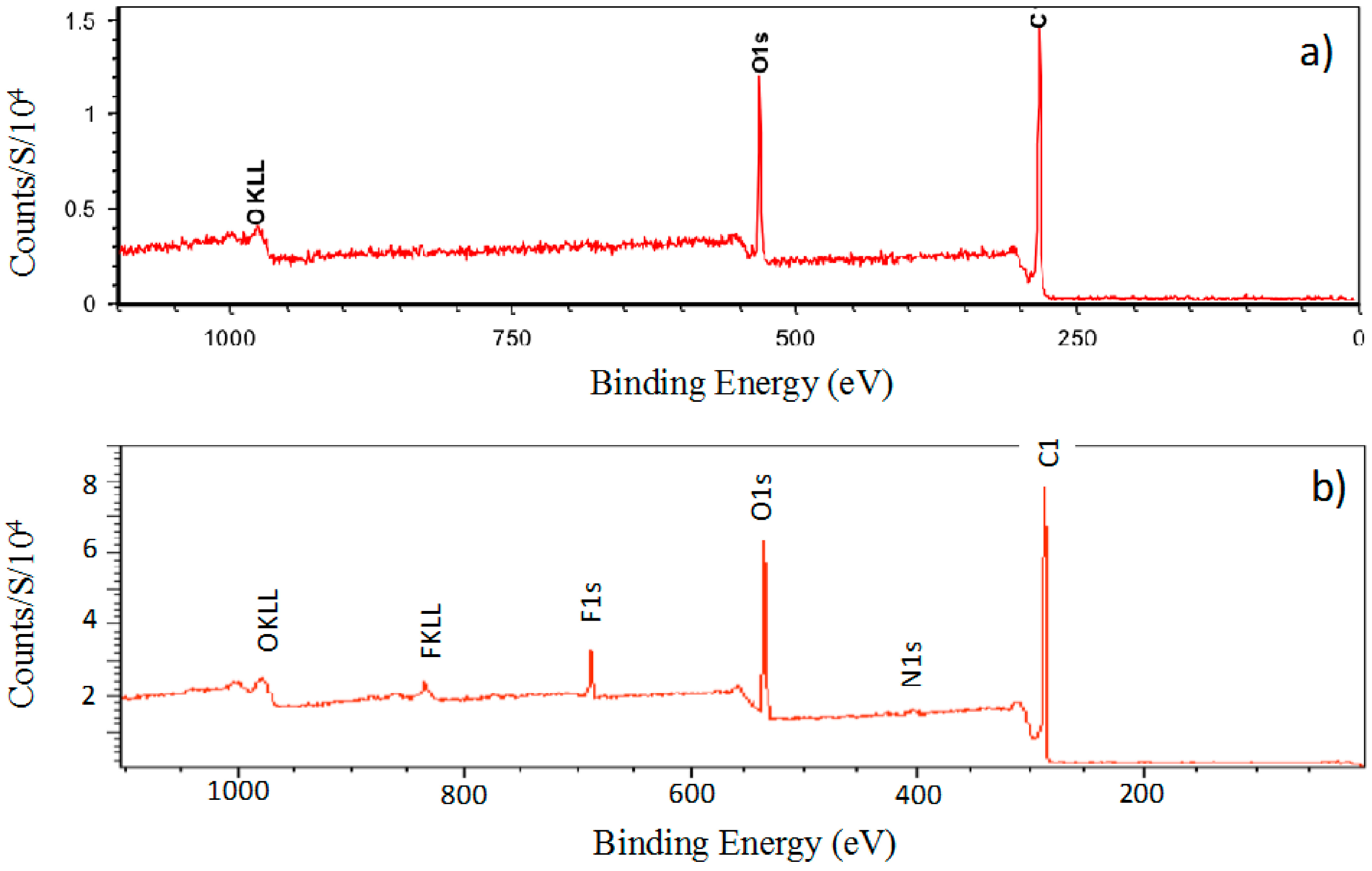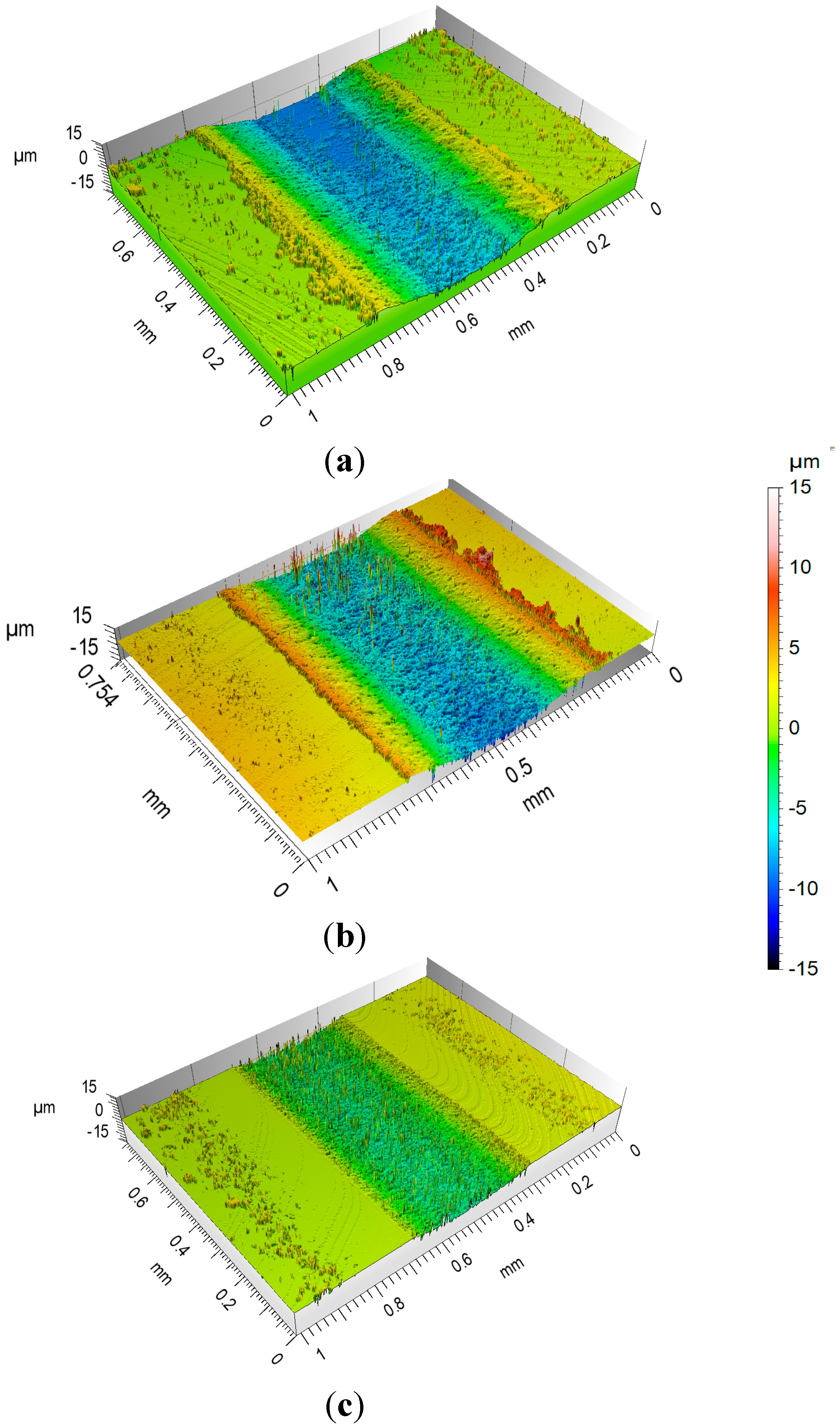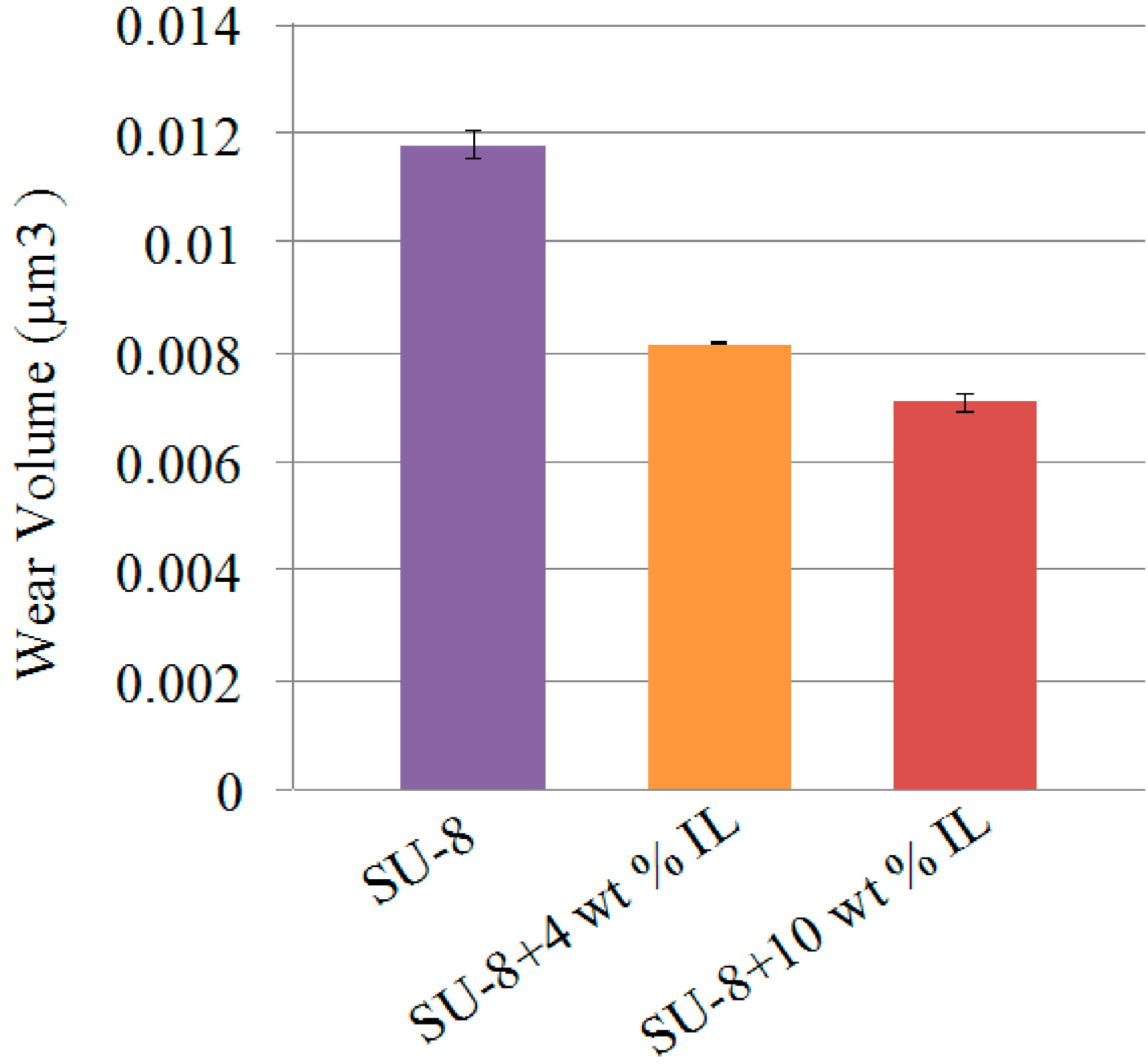1. Introduction
SU-8, an epoxy-type ultraviolet (UV) sensitive negative photoresist has attracted increasing attention since its introduction by IBM in 1989. This photoresist, initially used for photolithography, soon was used as resist in X-ray lithography [
1] e-beam lithography [
2] and as mold material for soft lithography of thermosetting elastomers such as poly(dimethyl siloxane) (PDMS) [
3]. Advantageous properties of this material including biocompatibility [
4], relative ease of fabrication methods, high chemical [
5], mechanical [
5] and thermal stability after processing [
4,
5] have found main applications in microelectromechanical systems (MEMS) and coatings and yet, applications are rapidly emerging today.
SU-8 can also be used for fabrication of molds for polymers. Examples include replica molding of poly(methyl methacrylate) (PMMA) and also casting molds for PDMS with many applications in microfluidics and chemical sensors [
6,
7]. However, SU-8 molds have the downside of early signs of delamination because of the stiction between the mold and substrate [
8].
Tribological properties, such as adhesion and wear, have a major effect on determining reliability of MEMS [
9]. Yet, despite vast application of SU-8 material in this domain only few investigations have been performed to address tribological issues of SU-8 resin. Based on the investigations of SU-8 counteracting tribological properties, three main approaches can be distinguished: surface texturing, external lubrication and bulk modification. The first category operates on the general basis that reduced area of contact can potentially lower the friction. Osborn
et al. have used connected and isolated microstructures of SU-8, with and without diamond-like carbon (DLC) coating (deposited on top of the SU-8) that acted as an outer, protective layer to improve the wear resistance. They obtained decreased coefficient of friction (COF) in rubbing tests against chrome steel ball by texturing isolated microstructured on SU-8 surface [
10]. However, texturing methods generally include multi-step complicated microfabrication process and require advanced cleanroom technology.
The second approach, external lubrication, implies surface functionalization of SU-8 by low shear strength thin films acting as lubricants. For example, Singh
et al., deposited lubricating perfluoropolyether (PFPE) to SU-8 surface through either physical or chemical surface modification and obtained lower coefficient of friction and wear [
11]. However, integrating the lubricant only to surface and through a pre-application process comes with a hitch: once the material starts to wear, lubricant will be removed from the surface. Moreover, since no replacement source is anticipated, lubrication can be demolished.
In the third method, SU-8 is blended with other compounds to fabricate a composite with enhanced tribological properties. Mixing of SU-8 with other compounds before processing is in general a very convenient way of tuning bulk and/or surface properties. Several properties of SU-8 such as electrical [
12], piezoelectric [
13] and tribological [
14] have been manipulated by compositing SU-8 with additives. However, to our knowledge, no investigations have so far been conducted on improving tribological properties of SU-8 through compositing with lubricating materials.
Ionic liquids are potentially interesting substances for lubricating technology. The term Ionic Liquid (IL) refers to a class of salts that are liquid in their pure state at near ambient temperature. These liquids are solely made of ions and in most cases have an organic cation and an inorganic, poly-atomic anion. Properties that make Ionic Liquids attractive materials in the field of chemistry and tribology include but are not limited to: marginal vapor pressure, good thermal stability (considerable gap between the melting point and the temperature of decomposition), characteristic electrical conductivity of an ionic conductor, low flammability, good dissolution with many organic and inorganic compounds and a wide variety of possible anions and cations combinations [
15]. Based on the extensive research invested on this material class, ILs have found emerging applications in sensors, solar cells, solid-state photocells, batteries, as thermal fluids, lubricants, solvents, reaction media, hydraulic fluids to name only a few [
16].
In summary, a material that presents desirable surface properties together with compatibility with MEMS fabrication processes can be very beneficial for many applications. Accordingly, the goal of the present work is to bring together advantageous properties of SU-8 and ionic liquids to overcome tribological shortcomings of the epoxy material by producing a composite material composed of an ionic liquid dispersed in a SU-8 matrix. In order to evaluate the potential of this composite for application in tribological coatings and MEMS, characteristics of the material including compatibility with photolithography process, wettability, and tribological properties, have been studied. Likely applications include but are not limited to self-lubricating coatings, structural MEMS material for moving parts and molds. In this study, two compositions of 4 and 10 wt % IL have been investigated.
2. Experimental Section
2.1. Materials and Sample Preparation
SU-8 epoxy grade GM1060 was supplied by Gersteltec Sarl, Pully, Switzerland. The ionic liquid used in this study was 1-Methyl-3-octylimidazolium hexafluorophosphate with purity ≥95.0% acquired from Sigma Aldrich. Schematics of both SU-8 and IL molecule used in this study are shown in
Figure 1. Glass substrate used for spin coating was obtained by cutting microscope slides with thickness of 1 mm into rectangles of 3 cm × 3 cm. The pieces were then thoroughly cleaned with soap and distilled water, rinsed with isopropanol and dried with nitrogen jet.
Figure 1.
Schematics of (a) 1-Methyl-3-octylimidazolium hexafluorophosphate and (b) SU-8 molecules.
Figure 1.
Schematics of (a) 1-Methyl-3-octylimidazolium hexafluorophosphate and (b) SU-8 molecules.
Composite fabrication method in this case is of crucial importance. Ideal lubrication is anticipated to occur as a result of homogeneous dispersion in forms of micro scale droplets in polymer matrix [
9]. Full dissolution of IL molecules in the epoxy matrix would hinder formation of a liquid IL lubricating film while large IL aggregations would prevent homogenous IL distribution over the entire rubbing surface and thus continuous lubrication.
A thickness of 50 micron neat SU-8 or SU-8/IL composite was spin coated at 565 rpm on the glass substrate followed by solvent evaporation at 120 °C and UV irradiated by a 7 mW/cm2 Lamp. Final step of post exposure bake was performed at 95 °C for 45 min to increase the crosslinking degree.
In this study, four mixing methods namely ultrasonification, rolling, mechanical mixing and magnetic stirring were evaluated. However, only mechanical mixing and magnetic stirring provided reproducible results. Following paragraphs will only be representing characterization of composites prepared via mechanical mixing.
2.2. X-Ray Photoelectron Spectroscopy (XPS)
The X-Ray Photoelectron Spectroscopy (XPS) measurements were performed using a Kratos AXIS ultrahigh-resolution spectrometer (Karatos Analytical Ltd, Manchester, UK). The machine uses a monochromatic Al Kα X-ray source and a take-off angle of 0° with respect to the surface normal. Curve fitting was performed using the commercial software package CasaXPS (Casa Software Ltd, Teignmouth, UK).
2.3. Wettability Characterization
Taking into account wide applications of SU-8 in lab-on-chips and microfluidics, it is certainly relevant to investigate effect of addition of the ionic liquid on water affinity of the epoxy material. In order to measure the contact angle, the water droplet method was used. The set up consists of a microscope with a numeric camera connected to a computer and a table to translate XYZ position that was placed in front of the microscope. A volume of 2 μL is deposited using a pipet. The contact angle was then manually measured on the captured photo. In each case measurements were performed twice.
2.4. UV Pattern-Ability
For applications in MEMS, the affordable resolution is key information in defining limitations in size and shape of structures and accordingly must be considered in design. Consequently, effect of IL on UV pattern-ability of the composite has been examined. Samples followed the same preparation steps as previously described and were exposed using a chromium mask with basic rectangular patterns. Following post-exposure bake, samples were developed in propylene glycol methyl ether acetate (PGMEA) during approximately 3 min.
2.5. Sliding Friction Apparatus and Test Conditions
Tribological tests were performed using a sliding friction apparatus (SFA) previously described in [
17]. Samples were rubbed against a carbon steel ball with diameter of 6 mm at room temperature and under relative humidity of 50%–60%. A normal force of 2 N was applied over duration of 15 min or 60 s with a frequency of 2 Hz and a sliding velocity of 20 mm/s. A computer equipped with LabView program (home-made) was in charge of constant monitoring of normal force, frictional force and pin displacement. Coefficient of friction was calculated by dividing frictional force by normal force measured in the middle of wear track. Tests were repeated two times to check for reproducibility of results.
According to Hertz contact stress theory for elastic contact between a sphere and a plane, stress at contact depends on normal load, contact area, Young’s modulus and Poisson’s ratio of the two materials in contact. Properties of SU-8, including mechanical properties, are highly dependent on process parameters. For Young’s Modulus, values ranging between 2.4 and 5.5 GPa have been measured depending on both process and test conditions [
18]. The Poisson ratio at room temperature has also been reported to vary between 0.3 and 0.4 [
19]. For the sake of following calculations, Young’s modulus and Poisson’s ratio have been considered to be equal to 4 GPa and 0.3, respectively. Steel ball had a diameter of 6 mm and applied normal force was equal to 2 N. For the above-mentioned conditions, the maximum contact pressure is calculated to be equal to 92.8 MPa. Such severe pressure is aimed at performing accelerated tests. Note that the contact pressure was calculated considering the bulk properties of SU-8. In case of a SU-8 film deposited on a much more rigid glass substrate, the contact pressure is expected to be higher, thus yielding even more severe test conditions.
2.6. Wear Calculation
Wear track topography was studied using SmartWLI-basic white-light interferometer. 3D profiles were then analyzed using MountainsMap analysis software. For wear rate calculation purposes, 2D linear profiles of wear track cross section were obtained at three points over the length of the wear track. Averaged cross-sectional area obtained from these three measurements was then multiplied by the wear track length to determine the wear volume.
4. Discussion
Contact angle measurement illustrates that addition of IL drastically affects water affinity of SU-8. Only by addition of 4% IL, SU-8 surface shifts towards a more hydrophilic behavior with the contact angle dropping to approximately 60 degrees. However, the relationship is not linear and further addition of IL up to 10% induces only small decrease of 2 degrees in contact angle. A low contact angle is in particular favorable for applications in microfluidics where capillary pressure is linearly related to cosine of contact angle. For the high thickness of film (50 microns) and the soft contact imposed between the mask and the film in this experiment, obtained resolution, as determined using optical microscopy, for SU-8/IL composite is comparable to that of pristine SU-8.
Sever wear has occurred for all three tested compositions over a test period of 15 min and a drastic amount of debris is formed. Yet, wear is effectively reduced as a result of IL addition and increasing amount of IL from 4 wt % to 10 wt % enhances this effect. Addition of IL has effectively reduced the wear of the material.
Addition of internal lubricant in both cases of 4 and 10 percent has effectively delayed start of wear process. This effect is expressed by a gradual increase in COF vs. time for the composite in contrast with the jump for pristine SU-8. It is also observed that the composite with a lower amount of additive has more successfully reduced COF.
On the whole it is observed that increasing IL content from 4% to 10% results in more effective wear reduction. However, the lubricating effect, which is symbolized by lower coefficient of friction, is more prevailing for lower lubricant content. This contrast can be explained through the double edged sward effect of ionic liquid in the SU-8 matrix. It is assumed that the ionic liquid, along-side lubrication, affects mechanical properties of SU-8. Meaning composite with lower IL content is more mechanically robust and consequently more successful in delaying start of wear. Yet, once wear and material deterioration starts, IL that is constrained in polymer matrix is released to wear track. At this point, the higher amount of lubricant that is released to the contact area of the two rubbing surfaces dominates wear process and compensates for lower mechanical robustness.











